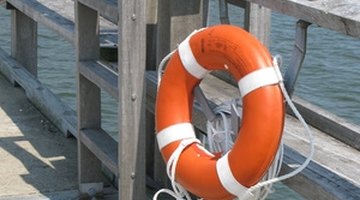How to Build Ohio Farm Ponds
Digging a farm pond can be a fulfilling project that affords the luxury of fishing, swimming, and wildlife observation, all on your property. However, in Ohio there is more to constructing a farm pond than digging a hole in the ground. Follow a few critical guidelines before you dive into a project of this scale.

-
Locate an area where standing water exists and aquatic plants like cattails, rushes, willows, or pond cypress are thriving. A wetland area may also indicate a pond is possible. Check with the Ohio Department of Natural Resources and Soil Survey to determine if your soil is suitable for pond construction. If you're unsure that the location is right for a pond, dig a test hole. Keep in mind that even a test hole could require a permit.
-
Contact your city and county governments and/or Ohio Environmental Protection Agency to determine if a permit is required to dig. City officials will also be able to tell you if gas piping or electrical lines are buried in your design site.
-
Dig a test hole to the pond's projected depth, using an auger or backhoe, to determine the depth of the water table. Ideally, the visible water level should be 2 or 3 feet from ground level. Since water levels will change seasonally, the test hole should be observed for one year, noting significant fluctuations. Cover the hole with a grate or fence around the hole as a safety precaution. Consider changing locations or building a shallow waterfowl pond if deep muck soils are revealed as it yields poor water quality and weak side slopes.
-
Plan your design. Dig to at least 10- to 15-feet deep if the pond is meant for swimming, while a fishing pond should be 15- to 20-feet in depth. Grade the banks of the pond no steeper than 3 to 1 (3 feet horizontal for every 1 foot vertical).
-
Contact at least three excavation companies for advice and estimates and select a contractor to dig your pond. Consider visiting several of their past projects to judge the quality and level of expertise. Dig your pond to your desired specifications.
-
Plant the area surrounding the pond with native aquatic plants like Canna lilies, pickerel weed and duck potato for shoreline retention and erosion control. Other benefits include a natural privacy buffer, space definition, climate control and wildlife habitat.
-
Post signs that show the depth of the pond as well as where life rings and preservers and the nearest telephone are located. Check with your homeowner's insurance company to see if this new liability requires changes to your policy.



References
Photo Credits
- duck in front of a pond image by Gina Smith from Fotolia.com
- cattails image by Pix by Marti from Fotolia.com
- canna lilly 44. image by mdb from Fotolia.com
- orange life ring on a fishing pier image by DSL from Fotolia.com
More Articles


